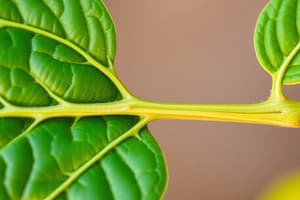Podcast
Questions and Answers
The walls of xylem vessels contain ______, which is a strong substance that provides support.
The walls of xylem vessels contain ______, which is a strong substance that provides support.
lignin
Xylem vessels are made up of living cells.
Xylem vessels are made up of living cells.
False (B)
Which of the following is NOT a factor affecting the rate of transpiration?
Which of the following is NOT a factor affecting the rate of transpiration?
- Humidity
- Air Movements
- Soil pH (correct)
- Light intensity
What is the main force that drives water up from the roots to the leaves?
What is the main force that drives water up from the roots to the leaves?
Match the following adaptations to their respective environments:
Match the following adaptations to their respective environments:
How does a plant wilt?
How does a plant wilt?
The movement of water from the soil to the root hair cells is driven by active transport.
The movement of water from the soil to the root hair cells is driven by active transport.
What is the role of cohesion and adhesion in water transport in plants?
What is the role of cohesion and adhesion in water transport in plants?
The evaporation of water from plant leaves is called ______.
The evaporation of water from plant leaves is called ______.
Xerophytes have adaptations to conserve water because they live in environments with abundant water.
Xerophytes have adaptations to conserve water because they live in environments with abundant water.
Which of the following is NOT a consequence of transpiration?
Which of the following is NOT a consequence of transpiration?
Explain how air movements affect the rate of transpiration.
Explain how air movements affect the rate of transpiration.
The opening and closing of ______ in leaves control the rate of transpiration.
The opening and closing of ______ in leaves control the rate of transpiration.
Water movement through xylem vessels is a passive process driven by energy from the sun.
Water movement through xylem vessels is a passive process driven by energy from the sun.
Which of the following adaptations would be beneficial for a plant living in a humid environment?
Which of the following adaptations would be beneficial for a plant living in a humid environment?
How does transpiration help to regulate the temperature of a plant?
How does transpiration help to regulate the temperature of a plant?
What do xylem vessels primarily transport within the plant?
What do xylem vessels primarily transport within the plant?
Phloem tubes transport water and minerals from the roots to the leaves.
Phloem tubes transport water and minerals from the roots to the leaves.
What is the substance that thickens the cell walls of xylem vessels, making them strong and impermeable?
What is the substance that thickens the cell walls of xylem vessels, making them strong and impermeable?
The tubes that carry sugar and organic nutrients in plants are called ______.
The tubes that carry sugar and organic nutrients in plants are called ______.
Match the following plant transport systems with their primary function:
Match the following plant transport systems with their primary function:
Which structure in plants primarily helps to reduce transpiration?
Which structure in plants primarily helps to reduce transpiration?
Phloem tissue is made up of dead cells.
Phloem tissue is made up of dead cells.
What is the main function of phloem tissue?
What is the main function of phloem tissue?
The movement of organic food such as sucrose in phloem is called __________.
The movement of organic food such as sucrose in phloem is called __________.
Match the following plant structures with their functions:
Match the following plant structures with their functions:
What is the main carbohydrate produced during photosynthesis?
What is the main carbohydrate produced during photosynthesis?
In phloem, the flow of nutrients is unidirectional.
In phloem, the flow of nutrients is unidirectional.
Areas where sucrose is produced in a plant are referred to as __________, while areas where it is utilized are known as __________.
Areas where sucrose is produced in a plant are referred to as __________, while areas where it is utilized are known as __________.
Flashcards
What is xylem?
What is xylem?
Xylem is a type of vascular tissue in plants that transports water and dissolved minerals from the roots to the leaves.
What is phloem?
What is phloem?
Phloem is another type of vascular tissue that transports sugars and other organic compounds produced during photosynthesis from the leaves to other parts of the plant.
What is lignin and what does it do?
What is lignin and what does it do?
Lignin is a complex polymer that strengthens and waterproofs cell walls, particularly in xylem vessels. This makes them rigid and prevents water loss.
How are xylem vessels structured?
How are xylem vessels structured?
Signup and view all the flashcards
How does water move through xylem?
How does water move through xylem?
Signup and view all the flashcards
Translocation
Translocation
Signup and view all the flashcards
What does xylem transport?
What does xylem transport?
Signup and view all the flashcards
What are sources in translocation?
What are sources in translocation?
Signup and view all the flashcards
What are sinks in translocation?
What are sinks in translocation?
Signup and view all the flashcards
What's the direction of flow in xylem?
What's the direction of flow in xylem?
Signup and view all the flashcards
What's the direction of flow in phloem?
What's the direction of flow in phloem?
Signup and view all the flashcards
What is the structure of xylem vessels?
What is the structure of xylem vessels?
Signup and view all the flashcards
What is the function of lignin in xylem vessels?
What is the function of lignin in xylem vessels?
Signup and view all the flashcards
Why are xylem cells dead?
Why are xylem cells dead?
Signup and view all the flashcards
How does water enter the root hair cells?
How does water enter the root hair cells?
Signup and view all the flashcards
How does water move through the root?
How does water move through the root?
Signup and view all the flashcards
What is the mechanism of transpiration pull?
What is the mechanism of transpiration pull?
Signup and view all the flashcards
What is transpiration?
What is transpiration?
Signup and view all the flashcards
How do cohesion and adhesion affect water transport?
How do cohesion and adhesion affect water transport?
Signup and view all the flashcards
What is the importance of transpiration in mineral ion transport?
What is the importance of transpiration in mineral ion transport?
Signup and view all the flashcards
How does transpiration contribute to plant support?
How does transpiration contribute to plant support?
Signup and view all the flashcards
How does transpiration support photosynthesis?
How does transpiration support photosynthesis?
Signup and view all the flashcards
How does transpiration help cool the plant?
How does transpiration help cool the plant?
Signup and view all the flashcards
What factors affect the rate of transpiration?
What factors affect the rate of transpiration?
Signup and view all the flashcards
What is wilting and how does it occur?
What is wilting and how does it occur?
Signup and view all the flashcards
What are xerophytes and what are their adaptations?
What are xerophytes and what are their adaptations?
Signup and view all the flashcards
Study Notes
Plant Transport Systems
- Plants have transport systems (xylem and phloem) to move water, minerals, and food.
- Xylem carries water and minerals from roots to leaves.
- Phloem carries sugars and other nutrients from leaves to other parts of the plant.
Leaf Structure
- Xylem and phloem are found in the midrib and veins of a leaf.
Stem Structure
- Stems contain vascular bundles with xylem and phloem.
- Food moves in the phloem; water and salts move in the xylem.
- Xylem and phloem cells form tubes (vessels, sieve tubes) supported by other cells.
Xylem Vessel Structure
- Xylem vessels are long, continuous tubes formed from interconnected cells.
- End walls of cells are digested away, creating a continuous tube.
- Cell walls are thickened with lignin for strength and impermeability.
- Cytoplasm of the cells dies, but this doesn't hinder water transport.
- Xylem also contains lignified supporting fibers.
Xylem Adaptations
- Thick, lignin-impregnated walls prevent water loss.
- Lignin makes xylem strong, preventing collapse from transpiration pull.
- Vessels are hollow, dead cells for efficient water movement.
- Vessels are joined end-to-end to form continuous tubes.
Water Movement
- Water enters root hairs by osmosis (from soil to roots).
- Water moves from cell to cell in the plant by osmosis, pushing water up.
- Transpiration (evaporation from leaves) creates a suction pull, drawing water up the xylem.
- Water moves in the transpiration stream through xylem (dead cells).
- Root pressure also contributes to water movement.
Transpiration
- Transpiration is the evaporation of water from leaves through stomata.
- It creates a suction pull that drives water movement up the stem.
- The movement of water through the plant is called the transpiration stream.
Transpiration Factors
- Light Intensity: Increased light leads to open stomata and increased transpiration.
- Humidity: Low humidity increases transpiration. High humidity slows it.
- Air Movement: Wind increases transpiration. Still air reduces it.
- Temperature: Warm temperatures increase transpiration.
Wilting
- Wilting occurs when water loss from leaves exceeds water uptake by roots.
- Cells become flaccid, and stems and leaves lose their rigidity.
Plant Adaptations to Dry Environments (Xerophytes)
- Xerophytes have adaptations to reduce water loss:
- Long roots for water absorption.
- Leaves that roll up or have sunken stomata.
- Fine hairs around stomata.
- Reduced leaves or spines.
- Reduced number of stomata.
- Stomata closed during the day.
- Fleshy stems for water storage.
- Needle-shaped leaves to reduce surface area.
- Thick waxy cuticle to prevent evaporation.
Phloem Structure
- Phloem is a tube next to xylem.
- Phloem is made of living, narrow cells connected by perforated sieve plates.
- Companion cells next to sieve tube elements have a nucleus but don't transport substances.
Translocation
- The movement of food (sucrose, amino acids) through the phloem is called translocation.
- Substances are moved from sources of production (leaves) to sinks of use (other cells).
- Glucose made in photosynthesis is transformed into sucrose for transport.
- Amino acids are also transported in the phloem.
- Different parts of the plant utilize the transported substances (respiration, growth).
Direction of Flow
- Xylem flow is unidirectional (roots to leaves).
- Phloem flow is bidirectional (from sources to sinks).
Studying That Suits You
Use AI to generate personalized quizzes and flashcards to suit your learning preferences.




